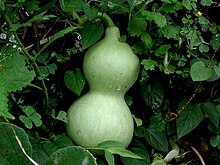> 1303 R. Mannyng Handlyng Synne 2105: He behelde a fruyt ryȝt feire and swete ‘Gourdys’ þus men clepe þe name.
It's (most immediately) from French, not Spanish.
Don't know how the French will have whittled down cucurbita into gourde though.
Oh I guess. c > g and t > d and skip the rest.
> 1382 Bible (Wycliffite, E.V.) Num. xi. 5: Into mynde come to vs the goordis [L. cucumeres], and the peponys, and the leeke, and the vniowns.
> c1440 Promptorium Parvulorum 203/2: Goord, cucumer, cucurbita.
Those "peponys" I would have taken for Spanish pepinos, so cucumbers like for pickles.
It might have been summer squash maybe, which are all Cucurbita pepo. But I thought that genus was American only.

Lagenaria is a genus of gourd-bearing vines in the squash family (Cucurbitaceae). Lagenaria contains six species, all of which are indigenous to tropical Africa. The best-known species, the calabash or bottle gourd, L. siceraria, has been domesticated by humans, and has spread beyond Africa. The other species are not cultivated. The gourds of the various species may be harvested young and used as a vegetable. More commonly, the gourds are harvested mature, then dried, and used in making utensils (including musical instruments and containers). Gourds of L. siceraria have been used to store water...
Oh gee, "calabash" for Latin Legenaria, but Spanish calabaza for pumpkins and such, calabacín for zucchini and kin. I still don’t think those earliest writers in English had Cucurbita genus squashes.
It's precipitating here again.
I hesitate to make a firm call on its kind, though. It was flurries a few minutes ago, but now I'm not sure.
> The generic name lagenaria comes from classical Latin lagena meaning bottle or flask, plus Latin suffix -aria.

The Cucurbitoideae are a subfamily of the flowering plant family Cucurbitaceae (gourds). The Cucurbitaceae are divided into two subfamilies, the Zanonioideae, probably a paraphyletic group of remainders, and the well-supported monophyletic Cucurbitoideae.The subfamily Cucurbitoideae consists of eight tribes. Members of the tribe Cucurbiteae produce economically valuable fruits, called gourds, which include crops like squashes (including pumpkins), luffas, and melons (including watermelons). The tribe Benincaseae contains a genus called Lagenaria whose members produce gourds that can be eaten when...
In biology, a tribe is a taxonomic rank above genus, but below family and subfamily. It is sometimes subdivided into subtribes. By convention, all taxonomic ranks above genus are capitalized, including both tribe and subtribe.
In zoology, the standard ending for the name of a zoological tribe is "-ini". Examples include the tribes Caprini (goat-antelopes), Hominini (hominins), Bombini (bumblebees), and Thunnini (tunas). The tribe Hominini is divided into subtribes by some scientists; subtribe Hominina then comprises "humans". The standard ending for the name of a zoological subtribe is "-ina"....
> In botany, the standard ending for the name of a botanical tribe is "-eae". Examples include the tribes Acalypheae and Hyacintheae. The tribe Hyacintheae is divided into subtribes, including the subtribe Massoniinae. The standard ending for the name of a botanical subtribe is "-inae".
They keep inventing new ones. :/
> According to Art 3.1 of the International Code of Nomenclature for algae, fungi, and plants (ICN) the most important ranks of taxa are: kingdom, division or phylum, class, order, family, genus, and species. According to Art 4.1 the secondary ranks of taxa are tribe, section, series, variety and form. There is an indeterminate number of ranks.
That last sentence has "is" where it needs "are". :(
> "An indeterminate number of people is standing outside the door."
Well, I cannot. Your mileage may vary.